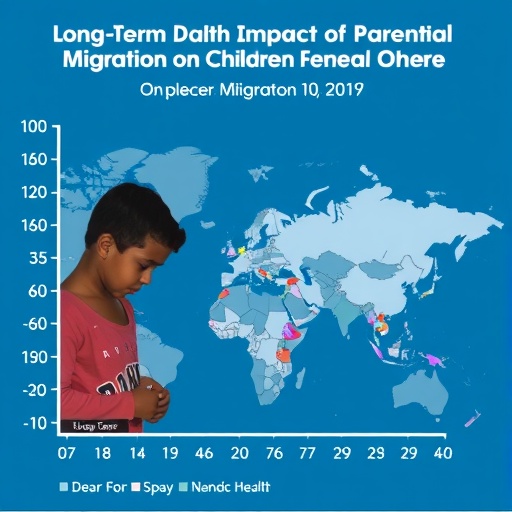The exodus of individuals from rural areas to urban centers in search of better economic prospects is a phenomenon that has been widely documented. This migration often results in the separation of families, a situation that has potentially profound implications for the children left behind. Researchers Feng and Meng delve into this pressing issue through their upcoming paper in the Journal of Population Research, raising critical questions about the long-term health effects of parental migration on children raised in these fragmented family structures.
In their investigation, the authors focus primarily on rural China, a region that has experienced significant migration trends in the past few decades. The phenomenon is not limited to China but is mirrored globally, where children often remain in their hometowns under the care of relatives or guardians while parents seek work in distant cities. This separation can carry both emotional and physical health consequences for these children, and Feng and Meng seek to elucidate these complex relationships.
Their research is grounded in a combination of qualitative and quantitative methodologies, employing comprehensive surveys and health assessments of children whose parents have migrated. By performing this extensive analysis, the researchers aim to paint a clearer picture of how parental absence can influence developmental outcomes. They hypothesize that children of migrant parents may face increased risks of physical health issues, mental health challenges, and diminished access to educational resources, all of which can compound over time.
A significant aspect of their findings centers around mental health outcomes. The stress and anxiety associated with parental separation can manifest in a myriad of ways, potentially leading to long-term psychological distress. The authors highlight studies showing that children may develop attachment issues, struggle with feelings of abandonment, or face social stigmatization connected to their family’s migration status. This insight emphasizes the need for more supportive frameworks to assist these children, particularly in the domains of mental health and social services.
Beyond mental health, Feng and Meng explore the physical health trajectories of these children. Preliminary data suggests that children of migrant workers may experience a higher prevalence of chronic health issues, such as respiratory diseases or malnutrition, which can be significantly influenced by the stability of their home environment. The authors call attention to the importance of nutrition, healthcare access, and security within the home in shaping long-term health outcomes for children. This may present an area for potential intervention, where policy changes could support better healthcare access for children left behind.
One of the more surprising findings from their research is the role of social networks in mediating health outcomes. Communities that maintain strong ties often provide some protective benefits against the adverse effects of parental absence. The researchers emphasize the importance of local institutions and relationships in fostering resilience among children in rural settings. This suggests a potential avenue for community-based programs aiming to bolster these support systems and mitigate the impact of separation on child health.
The implications of their work reach far beyond rural China, as these patterns can be seen in numerous countries where similar migration dynamics occur. As globalization encourages economic mobility, understanding the impacts of relocating on family structures and child well-being becomes increasingly crucial. The researchers urge policymakers worldwide to consider family dynamics when crafting immigration and labor policies, as well as broader social support systems.
The challenges posed by parental migration may not be easily solvable. However, Feng and Meng argue passionately for an integrated approach that combines health care, education, and social services to develop comprehensive support networks for affected children. They advocate for targeted educational programs that not only address academic needs but also encompass critical life skills and emotional wellbeing.
Looking ahead, the findings presented in this paper represent just the tip of the iceberg in understanding the intersection of migration, family dynamics, and child health. As researchers continue to unpack these relationships, it becomes clear that any solutions must incorporate the voices of children and families impacted by these migration patterns. Their narratives and experiences should be central to discussions regarding policy evolution and program development.
In conclusion, Feng and Meng’s work provides a crucial contribution to the ongoing conversation surrounding migration and child health. Their research serves as a call to action for educators, healthcare providers, and policymakers alike, urging them to recognize the complexities of family separation and its lasting impacts. As the world continues to grapple with migration, their insights shed light on the importance of nurturing the next generation in settings where parental migration is a common reality.
This significant research aims to foster a deeper understanding of how systemic changes can be effectively implemented to safeguard the health and wellbeing of children affected by parental migration, ensuring that these silent struggles do not go unnoticed amid the vast societal shifts we are witnessing.
Subject of Research: The long-term health effects of parental migration on children in rural China.
Article Title: Does parental migration have long-term health effects on children in later life? Evidence from rural China.
Article References:
Feng, Q., Meng, F. Does parental migration have long-term health effects on children in later life? Evidence from rural China.
J Pop Research 42, 49 (2025). https://doi.org/10.1007/s12546-025-09404-y
Image Credits: AI Generated
DOI: 10.1007/s12546-025-09404-y
Keywords: parental migration, child health, rural China, mental health, health outcomes, community support systems, socioeconomic factors.




